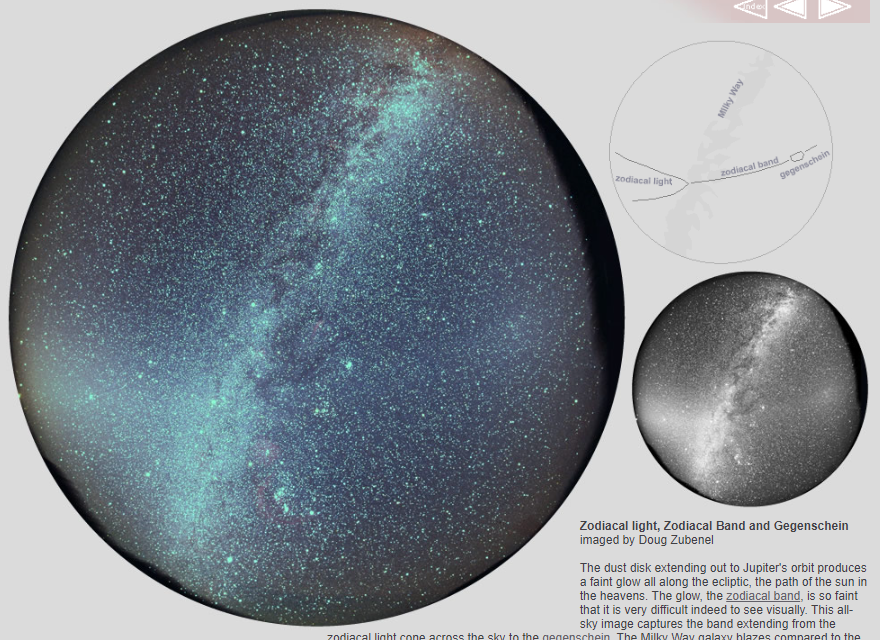Zodiacal Light, Zodiacal Band, Gegenschein and Red Airglow
Zodiacal Light, Zodiacal Band, Gegenschein, and Red Airglow: A Spectacular Display in the Night Sky
The night sky never ceases to amaze us with its myriad of celestial phenomena. Among these captivating displays are the Zodiacal Light, Zodiacal Band, Gegenschein, and Red Airglow. While these may not be as well-known as other astronomical phenomena, they are truly awe-inspiring in their own right.
The Zodiacal Light is a faint glow that extends along the ecliptic, which is the path of the Sun in the heavens. This ethereal glow is produced by the dust disk that extends all the way to Jupiter's orbit. The Zodiacal Band, on the other hand, refers to the portion of the Zodiacal Light that spans across the sky. It is so dim that observing it visually can be quite challenging.
To capture the full extent of these celestial wonders, astrophotographers like Doug Zubenel employ their skills and equipment to create stunning all-sky images. One such image captured by Zubenel showcases the Zodiacal Band stretching from the Zodiacal Light cone to the Gegenschein. In this awe-inspiring photograph, the Milky Way galaxy shines brightly in comparison to the fainter light emitted by our solar system's dust cloud. Additionally, the image reveals another captivating phenomenon known as red airglow, which bathes the horizon in a mesmerizing crimson hue.
Zubenel's photograph was captured using a homemade camera equipped with a Mamiya 120 film back and a Nikkor 16mm f/2.8 fisheye lens. To enhance the image quality, Zubenel stopped down the lens to f/4 and used Kodak E200 120 film pushed to ISO 800. The photograph was taken during the 24th annual Okie-Tex Star Party in Cimarron County, Oklahoma.
While the existing content provides a glimpse into the beauty of these atmospheric optics phenomena, let's delve deeper into each of them:
1. Zodiacal Light
- The Zodiacal Light is caused by sunlight reflecting off dust particles in the plane of the Solar System.
- It appears as a faint cone of light that extends along the ecliptic.
- The best time to observe Zodiacal Light is after sunset or before sunrise when the sky is dark.
2. Zodiacal Band
- The Zodiacal Band refers to the portion of the Zodiacal Light that spans across the sky.
- It appears as a faint band of light that follows the same path as the Zodiacal Light.
- The Zodiacal Band is most visible in areas with minimal light pollution.
3. Gegenschein
- The Gegenschein is a faint patch of light located opposite the Sun in the night sky.
- It is caused by sunlight reflecting off interplanetary dust particles in the direction opposite to the Sun.
- The Gegenschein is often difficult to observe due to its faintness, but can be visible under ideal conditions.
4. Red Airglow
- Red Airglow is a natural phenomenon that causes a reddish glow in the Earth's atmosphere.
- It is caused by various chemical reactions and interactions between molecules in the upper atmosphere.
- Red Airglow is most prominent near the horizon and can create stunning visual effects when combined with other atmospheric optics phenomena.
As we gaze up at the night sky, it's incredible to think about the vastness of our universe and the intricate interplay of light and matter that gives rise to these captivating phenomena. The Zodiacal Light, Zodiacal Band, Gegenschein, and Red Airglow offer us a glimpse into the hidden wonders of our celestial surroundings. Whether observed through astrophotography or experienced firsthand, these atmospheric optics phenomena never fail to leave us in awe of the beauty and complexity of our universe.

Zodiacal light, Zodiacal Band and Gegenschein imaged by Doug Zubenel
The dust disk extending out to Jupiter's orbit produces a faint glow all along the ecliptic, the path of the sun in the heavens. The glow, the zodiacal band, is so faint that it is very difficult indeed to see visually. This all-sky image captures the band extending from the zodiacal light cone across the sky to the gegenschein. The Milky Way galaxy blazes compared to the dimmer light of our solar system dust cloud. Even closer to home, red airglow lights the sky around the horizon.
"The all-sky shot is a 20 minute exposure centered on 10:05 UT Oct. 10, 2007. It is with my homemade camera (a Mamiya 120 film back with an interface for carrying a Nikkor 16mm f/2.8 fisheye and other lenses). The 16mm lens was stopped down to f/4. Kodak E200 120 film was pushed to ISO 800. It, was taken at the 24th annual Okie-Tex Star Party located in Cimarron County, Oklahoma (in the extreme NW tip of the panhandle in western Oklahoma)."
Image ©Doug Zubenel, shown with permission.
Note: this article has been automatically converted from the old site and may not appear as intended. You can find the original article here.
Reference Atmospheric Optics
If you use any of the definitions, information, or data presented on Atmospheric Optics, please copy the link or reference below to properly credit us as the reference source. Thank you!
-
<a href="https://atoptics.co.uk/blog/zodiacal-light-zodiacal-band-gegenschein-and-red-airglow/">Zodiacal Light, Zodiacal Band, Gegenschein and Red Airglow</a>
-
"Zodiacal Light, Zodiacal Band, Gegenschein and Red Airglow". Atmospheric Optics. Accessed on April 28, 2024. https://atoptics.co.uk/blog/zodiacal-light-zodiacal-band-gegenschein-and-red-airglow/.
-
"Zodiacal Light, Zodiacal Band, Gegenschein and Red Airglow". Atmospheric Optics, https://atoptics.co.uk/blog/zodiacal-light-zodiacal-band-gegenschein-and-red-airglow/. Accessed 28 April, 2024
-
Zodiacal Light, Zodiacal Band, Gegenschein and Red Airglow. Atmospheric Optics. Retrieved from https://atoptics.co.uk/blog/zodiacal-light-zodiacal-band-gegenschein-and-red-airglow/.